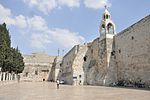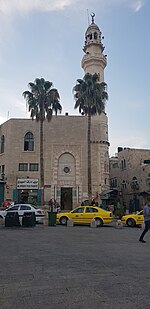Bethlehem (; Arabic: بيت لحم, Bayt Laḥm, ; Hebrew: בֵּית לֶחֶם Bēṯ Leḥem) is a city in the Israeli-occupied West Bank, Palestine, located about 10 kilometres (6.2 mi) south of Jerusalem. It is the capital of the Bethlehem Governorate, and has a population of approximately 25,000 people. The city's economy is largely tourist-driven; international tourism peaks around and during Christmas, when Christians embark on a pilgrimage to the Church of the Nativity, revered as the location of the Nativity of Jesus.The earliest-known mention of Bethlehem is in the Amarna correspondence of ancient Egypt, dated to 1350–1330 BCE, when the town was inhabited by the Canaanites. In the Hebrew Bible, the period of the Israelites is described; it identifies Bethlehem as the birthplace of David. In the New Testament, the city is identified as the birthplace of Jesus of Nazareth. Under the Roman Empire, the city of Bethlehem was destroyed by Hadrian, but later rebuilt by Helena, and her son, Constantine the Great, who commissioned the Church of the Nativity in 327 CE. In 529, the Church of the Nativity was heavily damaged by Samaritans involved in the Samaritan revolts; following the victory of the Byzantine Empire, it was rebuilt by Justinian I.
Amidst the Muslim conquest of the Levant, Bethlehem became part of Jund Filastin in 637. Muslims continued to rule the city until 1099, when it was conquered by the Crusaders, who replaced the local Christian clergy—composed of representatives from the Greek Orthodox Church—with representatives from the Catholic Church. In the mid-13th century, Bethlehem's walls were demolished by the Mamluk Sultanate. However, they were rebuilt by the Ottoman Empire in the 16th century, following the Ottoman–Mamluk War. After the dissolution of the Ottoman Empire at the end of World War I, it became part of Mandatory Palestine until 1948, when it was annexed by Jordan during the 1948 Arab–Israeli War. During the 1967 Six Day War, Bethlehem was occupied by Israel along with the rest of the West Bank. Since the Oslo Accords between Israel and the Palestinian National Authority, Bethlehem has been designated as part of Area A of the West Bank, nominally rendering it as being under Palestinian control. Movement around the city is limited due to the Israeli West Bank barrier.
While it was historically a city of Arab Christians, Bethlehem now has a majority of Arab Muslims; it is still home to a significant community of Palestinian Christians, however it has dwindled significantly, mostly due to difficulties resulting from living under the Israeli occupation. Presently, Bethlehem has become encircled by dozens of Israeli settlements, which significantly hinder the ability of Palestinians in the city to openly access their land and livelihoods, which has contributed to the exodus of Palestinians.











